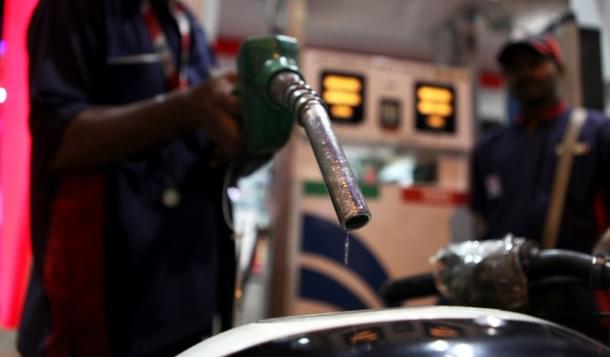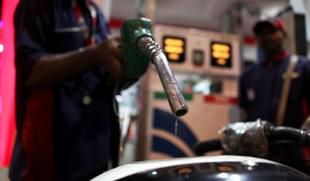Economy
Why The Onus Of Reducing Taxes On Petrol, Diesel Is Now On States
Sindhu Bhattacharya
Jan 29, 2018, 10:31 AM | Updated 10:31 AM IST
Save & read from anywhere!
Bookmark stories for easy access on any device or the Swarajya app.


The centre may succumb to political compulsions and lower excise duty on petrol and diesel in the upcoming union budget 2018, as pump prices of both these fuels have been spiraling over the last few weeks. Both petrol and diesel are being sold at the pumps at three-year highs as prices of brent crude spiral in the international market – India is an oil-consuming nation and pump prices rise as per international prices.
India is also one of those countries which levies exceptionally high taxes – central and state levies – on these fuels. Petrol and diesel prices are usually a political hot potato, since any sustained increase is seen as fuelling inflation.
Besides, since mid-2014, when crude prices began falling, the government did not cut back on taxes, saying the extra revenue mop-up will help it fund welfare schemes for the poor. This meant that when global prices were low, Indians did not benefit from lower pump prices. Only after widespread outcry, the centre finally slashed excise duty by about Rs 2 per litre around Diwali last year, and this led to a significant relief in pump prices. But even after the centre did its bit, was it not incumbent upon states to follow and offer a cut in value added tax (VAT) or sales tax? Except for five states, no other state came forward to cut VAT. At last count, anywhere up to 40 per cent of states’ revenues comes from the taxes on these two fuels and most are wary of cutting back on taxes on revenue considerations.
Now, as the Petroleum and Natural Gas Ministry has itself petitioned the Finance Ministry for a cut in excise levy on both fuels in the upcoming budget, the question is: Will states do their bit or once again hide behind the “we will lose revenue” line and shirk from their duty? Why should the centre have to bear the entire burden?
As this piece suggests, the ministry has already petitioned the government for an excise cut.
If the centre does cut excise, it would of course provide a huge relief to the aam aadmi (common man). But as we said earlier, after central excise duty was slashed in October, only five states, namely Gujarat, Maharashtra, Himachal Pradesh, Madhya Pradesh and Uttarakhand, pruned VAT. This time, it would be good politics for even state governments to show some mercy to the aam aadmi.
Not just through a VAT reduction, states must additionally also try to bring petroleum products under the goods and services (GST) tax regime eventually so that total taxation on these two fuels is rationalised. Right now, VAT varies wildly from one state to another, making taxation and pricing quite haphazard. GST would probably bring some semblance of sanity into petro products’ pricing, even if there are still some questions on whether it will result in any significant drop in pump prices.
Remember, prices of petrol and diesel were made market-determined from June 2010 and October 2014, respectively. Since then, Oil Marketing Companies (OMCs) have decided the pricing of both fuels in line with international product prices and other market conditions. And since last year, there is a daily price revision for both fuels, against the fortnightly revision done earlier. Some state governments or political parties have even begun demanding a rollback of this practice of daily price revision in petrol and diesel, saying a less frequent revision will cushion the aam aadmi from daily fluctuations.
Now, Mumbai city levies the steepest duties on both fuels anywhere in the country, at a little over Rs 22 on petrol and over Rs 12 on diesel. That means, at current prices, more than a fourth of what you pay at the pump to get a litre of petrol goes to the state government’s kitty in Mumbai. Add another about Rs 20 on account of central excise and almost half of what you pay for a litre goes in sundry taxes. Petrol prices have already breached the Rs 80 a litre mark in Mumbai this week.
Neighbouring Goa, however, imposes the lowest VAT on petrol anywhere in the country, at just below Rs 9. So, not only are the two fuels highly taxed, there is a rather wide variation in state-level taxation across the country. Since mid-December, petrol prices have risen by well over Rs 3 per litre and diesel by almost Rs 5 per litre on rising prices of crude. According to a note by brokerage India Infoline, if brent crude price increases to $85 a barrel (it hovered around $70 a barrel on 24 January), prices of petrol and diesel would need to be increased by Rs 13-15 per litre under the current pricing mechanism.
As this piece points out, the centre raised excise duty nine times between November 2014 and January 2016 to take advantage of falling crude prices and shore up public finances. This obviously meant that all gains from low brent crude prices did not reach the aam aadmi during the first 15 months of the National Democratic Alliance government at the centre. The excise duty on petrol was hiked by Rs 11.77 per litre and that on diesel by 13.47 a litre in these 15 months. Also remember, as much as Rs 4.4 lakh crore was generated in 2016-17 by the centre through various taxes and levies on petrol and diesel. As of now, excise duty collections from diesel and petrol sales constitute 84-87 per cent of the overall excise tax collections. This means 20 per cent or about a fifth of the central government’s total tax collection comes from the taxes you and I pay to buy these fuels.
Back to the GST puzzle, opinions vary on whether putting petrol and diesel under GST will help the aam aadmi. Some experts say that since states depend rather heavily for revenue from taxation on these two products, they could demand that both fuels are kept in the highest tax slab under GST, of 28 per cent, and also attract an additional cess. This could mean only a marginal relief to the aam aadmi in pump prices. But some others say that despite all these hurdles, getting the two fuels under GST would be the only way forward in the long run, to smoothen out taxation glitches and provide at least some price relief.
Sindhu Bhattacharya is a senior journalist.





